Sugar Tax: Economic Analysis - Deakin University, MPE781 Assignment
VerifiedAdded on 2023/01/23
|15
|3961
|64
Report
AI Summary
This report provides an economic analysis of taxing sugar, addressing its classification as a luxury good, the impact of taxes on luxury goods, and the distribution of the tax burden between consumers and vendors. It explores the concept of elasticity of demand, particularly in the context of sugar consumption, and examines how taxes affect consumer behavior and government revenue. Furthermore, the report discusses the potential for deadweight loss resulting from taxation and the broader implications for economic efficiency. The analysis also touches on the potential benefits of sugar taxes, such as improved public health and increased economic productivity. This assignment is available on Desklib, a platform offering a wide range of study resources including past papers and solved assignments to support students.

Taxing Sugar 1
TAXING SUGAR
By Student's Name
Course Code and Name
Professor’s Name
University Name
City, State
Date of Submission
TAXING SUGAR
By Student's Name
Course Code and Name
Professor’s Name
University Name
City, State
Date of Submission
Paraphrase This Document
Need a fresh take? Get an instant paraphrase of this document with our AI Paraphraser
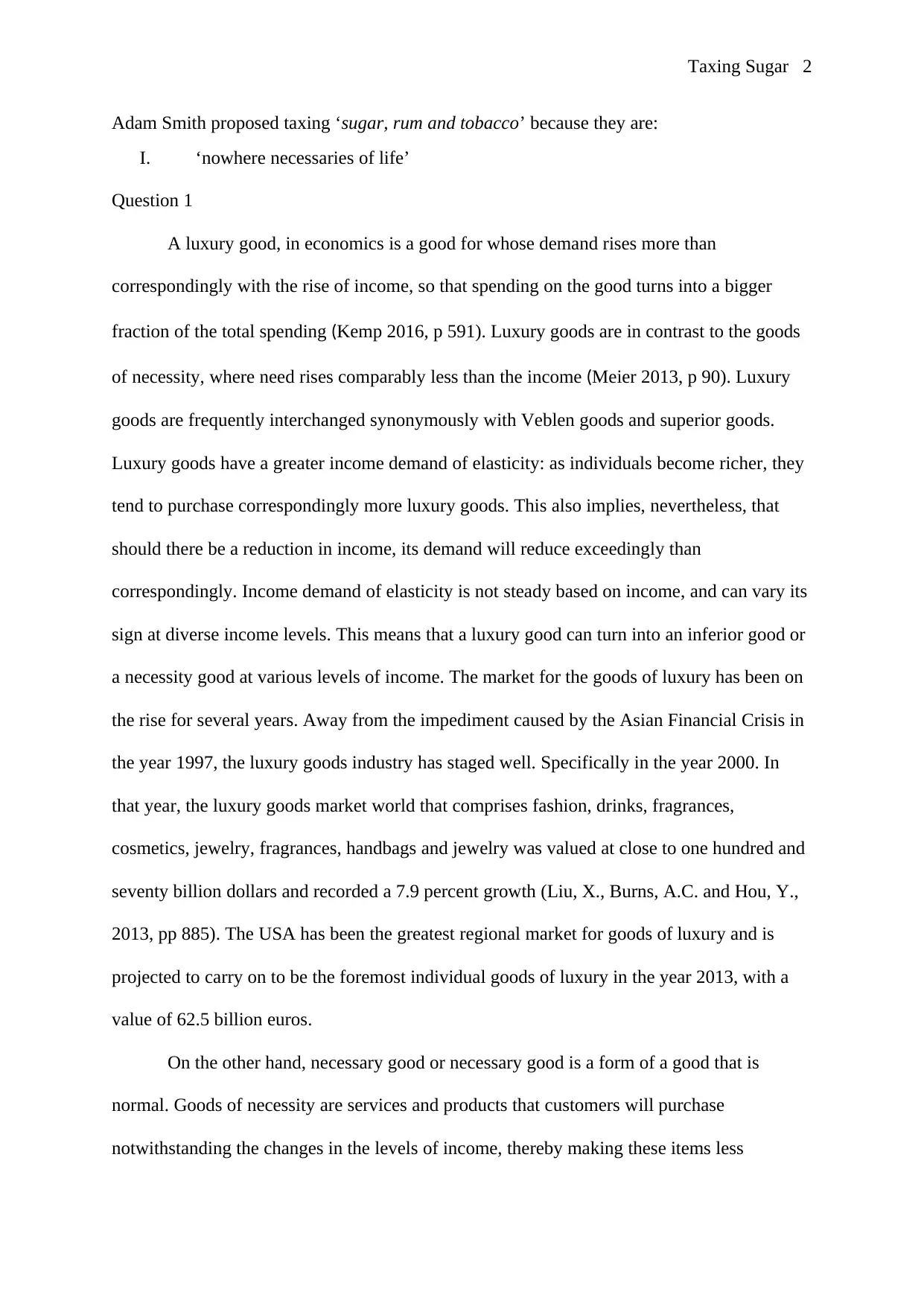
Taxing Sugar 2
Adam Smith proposed taxing ‘sugar, rum and tobacco’ because they are:
I. ‘nowhere necessaries of life’
Question 1
A luxury good, in economics is a good for whose demand rises more than
correspondingly with the rise of income, so that spending on the good turns into a bigger
fraction of the total spending (Kemp 2016, p 591). Luxury goods are in contrast to the goods
of necessity, where need rises comparably less than the income (Meier 2013, p 90). Luxury
goods are frequently interchanged synonymously with Veblen goods and superior goods.
Luxury goods have a greater income demand of elasticity: as individuals become richer, they
tend to purchase correspondingly more luxury goods. This also implies, nevertheless, that
should there be a reduction in income, its demand will reduce exceedingly than
correspondingly. Income demand of elasticity is not steady based on income, and can vary its
sign at diverse income levels. This means that a luxury good can turn into an inferior good or
a necessity good at various levels of income. The market for the goods of luxury has been on
the rise for several years. Away from the impediment caused by the Asian Financial Crisis in
the year 1997, the luxury goods industry has staged well. Specifically in the year 2000. In
that year, the luxury goods market world that comprises fashion, drinks, fragrances,
cosmetics, jewelry, fragrances, handbags and jewelry was valued at close to one hundred and
seventy billion dollars and recorded a 7.9 percent growth (Liu, X., Burns, A.C. and Hou, Y.,
2013, pp 885). The USA has been the greatest regional market for goods of luxury and is
projected to carry on to be the foremost individual goods of luxury in the year 2013, with a
value of 62.5 billion euros.
On the other hand, necessary good or necessary good is a form of a good that is
normal. Goods of necessity are services and products that customers will purchase
notwithstanding the changes in the levels of income, thereby making these items less
Adam Smith proposed taxing ‘sugar, rum and tobacco’ because they are:
I. ‘nowhere necessaries of life’
Question 1
A luxury good, in economics is a good for whose demand rises more than
correspondingly with the rise of income, so that spending on the good turns into a bigger
fraction of the total spending (Kemp 2016, p 591). Luxury goods are in contrast to the goods
of necessity, where need rises comparably less than the income (Meier 2013, p 90). Luxury
goods are frequently interchanged synonymously with Veblen goods and superior goods.
Luxury goods have a greater income demand of elasticity: as individuals become richer, they
tend to purchase correspondingly more luxury goods. This also implies, nevertheless, that
should there be a reduction in income, its demand will reduce exceedingly than
correspondingly. Income demand of elasticity is not steady based on income, and can vary its
sign at diverse income levels. This means that a luxury good can turn into an inferior good or
a necessity good at various levels of income. The market for the goods of luxury has been on
the rise for several years. Away from the impediment caused by the Asian Financial Crisis in
the year 1997, the luxury goods industry has staged well. Specifically in the year 2000. In
that year, the luxury goods market world that comprises fashion, drinks, fragrances,
cosmetics, jewelry, fragrances, handbags and jewelry was valued at close to one hundred and
seventy billion dollars and recorded a 7.9 percent growth (Liu, X., Burns, A.C. and Hou, Y.,
2013, pp 885). The USA has been the greatest regional market for goods of luxury and is
projected to carry on to be the foremost individual goods of luxury in the year 2013, with a
value of 62.5 billion euros.
On the other hand, necessary good or necessary good is a form of a good that is
normal. Goods of necessity are services and products that customers will purchase
notwithstanding the changes in the levels of income, thereby making these items less
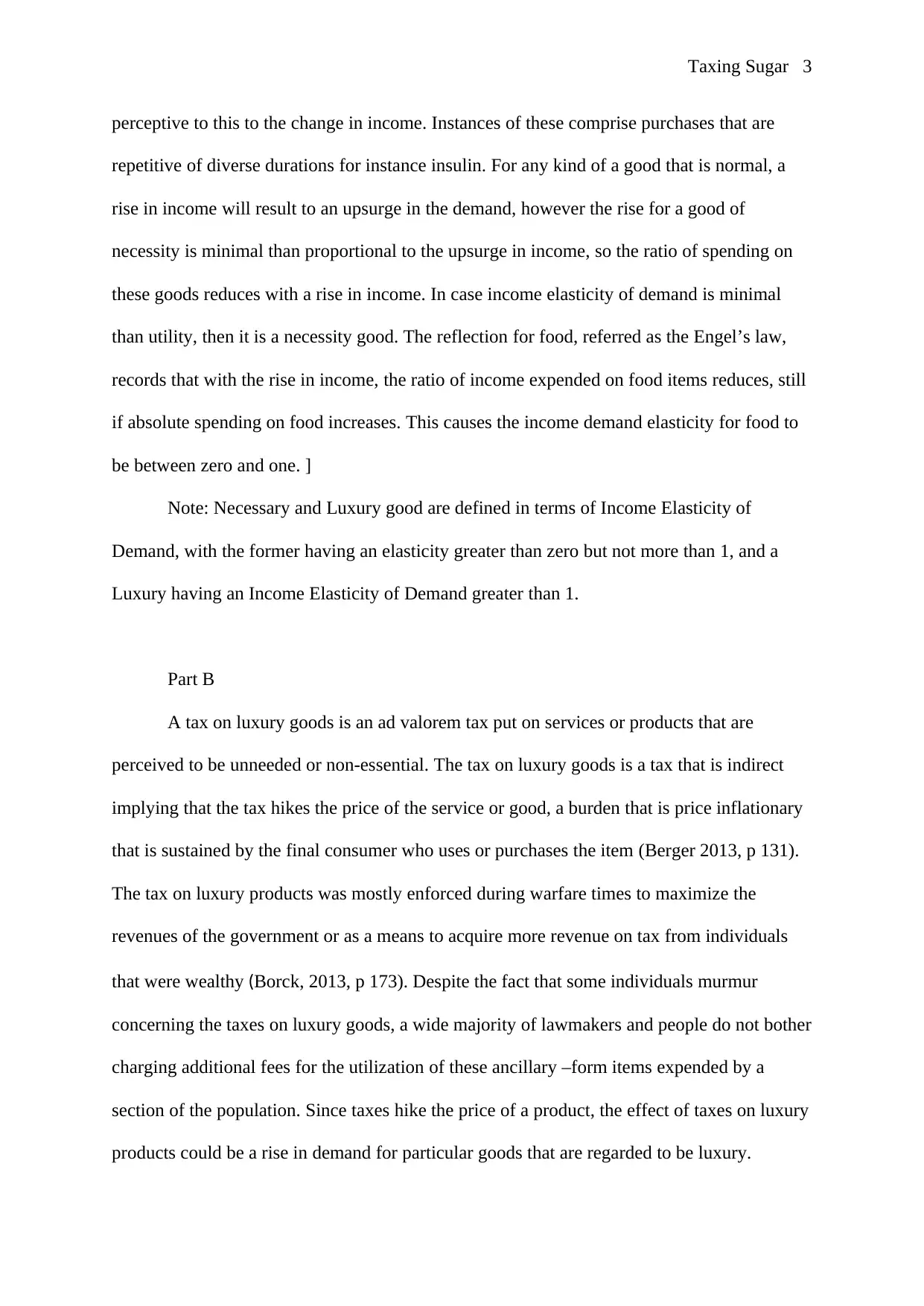
Taxing Sugar 3
perceptive to this to the change in income. Instances of these comprise purchases that are
repetitive of diverse durations for instance insulin. For any kind of a good that is normal, a
rise in income will result to an upsurge in the demand, however the rise for a good of
necessity is minimal than proportional to the upsurge in income, so the ratio of spending on
these goods reduces with a rise in income. In case income elasticity of demand is minimal
than utility, then it is a necessity good. The reflection for food, referred as the Engel’s law,
records that with the rise in income, the ratio of income expended on food items reduces, still
if absolute spending on food increases. This causes the income demand elasticity for food to
be between zero and one. ]
Note: Necessary and Luxury good are defined in terms of Income Elasticity of
Demand, with the former having an elasticity greater than zero but not more than 1, and a
Luxury having an Income Elasticity of Demand greater than 1.
Part B
A tax on luxury goods is an ad valorem tax put on services or products that are
perceived to be unneeded or non-essential. The tax on luxury goods is a tax that is indirect
implying that the tax hikes the price of the service or good, a burden that is price inflationary
that is sustained by the final consumer who uses or purchases the item (Berger 2013, p 131).
The tax on luxury products was mostly enforced during warfare times to maximize the
revenues of the government or as a means to acquire more revenue on tax from individuals
that were wealthy (Borck, 2013, p 173). Despite the fact that some individuals murmur
concerning the taxes on luxury goods, a wide majority of lawmakers and people do not bother
charging additional fees for the utilization of these ancillary –form items expended by a
section of the population. Since taxes hike the price of a product, the effect of taxes on luxury
products could be a rise in demand for particular goods that are regarded to be luxury.
perceptive to this to the change in income. Instances of these comprise purchases that are
repetitive of diverse durations for instance insulin. For any kind of a good that is normal, a
rise in income will result to an upsurge in the demand, however the rise for a good of
necessity is minimal than proportional to the upsurge in income, so the ratio of spending on
these goods reduces with a rise in income. In case income elasticity of demand is minimal
than utility, then it is a necessity good. The reflection for food, referred as the Engel’s law,
records that with the rise in income, the ratio of income expended on food items reduces, still
if absolute spending on food increases. This causes the income demand elasticity for food to
be between zero and one. ]
Note: Necessary and Luxury good are defined in terms of Income Elasticity of
Demand, with the former having an elasticity greater than zero but not more than 1, and a
Luxury having an Income Elasticity of Demand greater than 1.
Part B
A tax on luxury goods is an ad valorem tax put on services or products that are
perceived to be unneeded or non-essential. The tax on luxury goods is a tax that is indirect
implying that the tax hikes the price of the service or good, a burden that is price inflationary
that is sustained by the final consumer who uses or purchases the item (Berger 2013, p 131).
The tax on luxury products was mostly enforced during warfare times to maximize the
revenues of the government or as a means to acquire more revenue on tax from individuals
that were wealthy (Borck, 2013, p 173). Despite the fact that some individuals murmur
concerning the taxes on luxury goods, a wide majority of lawmakers and people do not bother
charging additional fees for the utilization of these ancillary –form items expended by a
section of the population. Since taxes hike the price of a product, the effect of taxes on luxury
products could be a rise in demand for particular goods that are regarded to be luxury.
⊘ This is a preview!⊘
Do you want full access?
Subscribe today to unlock all pages.

Trusted by 1+ million students worldwide
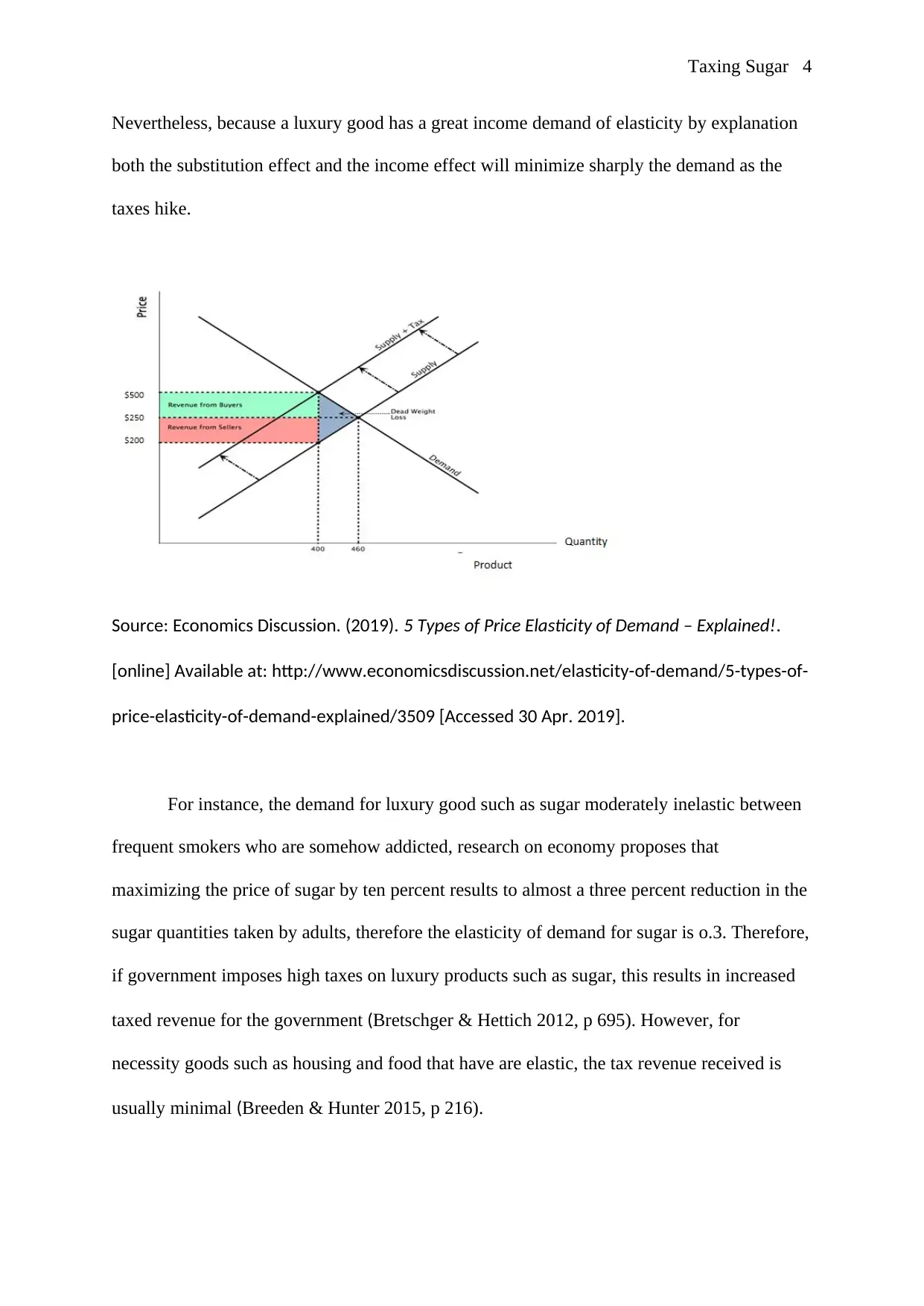
Taxing Sugar 4
Nevertheless, because a luxury good has a great income demand of elasticity by explanation
both the substitution effect and the income effect will minimize sharply the demand as the
taxes hike.
Source: Economics Discussion. (2019). 5 Types of Price Elasticity of Demand – Explained!.
[online] Available at: http://www.economicsdiscussion.net/elasticity-of-demand/5-types-of-
price-elasticity-of-demand-explained/3509 [Accessed 30 Apr. 2019].
For instance, the demand for luxury good such as sugar moderately inelastic between
frequent smokers who are somehow addicted, research on economy proposes that
maximizing the price of sugar by ten percent results to almost a three percent reduction in the
sugar quantities taken by adults, therefore the elasticity of demand for sugar is o.3. Therefore,
if government imposes high taxes on luxury products such as sugar, this results in increased
taxed revenue for the government (Bretschger & Hettich 2012, p 695). However, for
necessity goods such as housing and food that have are elastic, the tax revenue received is
usually minimal (Breeden & Hunter 2015, p 216).
Nevertheless, because a luxury good has a great income demand of elasticity by explanation
both the substitution effect and the income effect will minimize sharply the demand as the
taxes hike.
Source: Economics Discussion. (2019). 5 Types of Price Elasticity of Demand – Explained!.
[online] Available at: http://www.economicsdiscussion.net/elasticity-of-demand/5-types-of-
price-elasticity-of-demand-explained/3509 [Accessed 30 Apr. 2019].
For instance, the demand for luxury good such as sugar moderately inelastic between
frequent smokers who are somehow addicted, research on economy proposes that
maximizing the price of sugar by ten percent results to almost a three percent reduction in the
sugar quantities taken by adults, therefore the elasticity of demand for sugar is o.3. Therefore,
if government imposes high taxes on luxury products such as sugar, this results in increased
taxed revenue for the government (Bretschger & Hettich 2012, p 695). However, for
necessity goods such as housing and food that have are elastic, the tax revenue received is
usually minimal (Breeden & Hunter 2015, p 216).
Paraphrase This Document
Need a fresh take? Get an instant paraphrase of this document with our AI Paraphraser
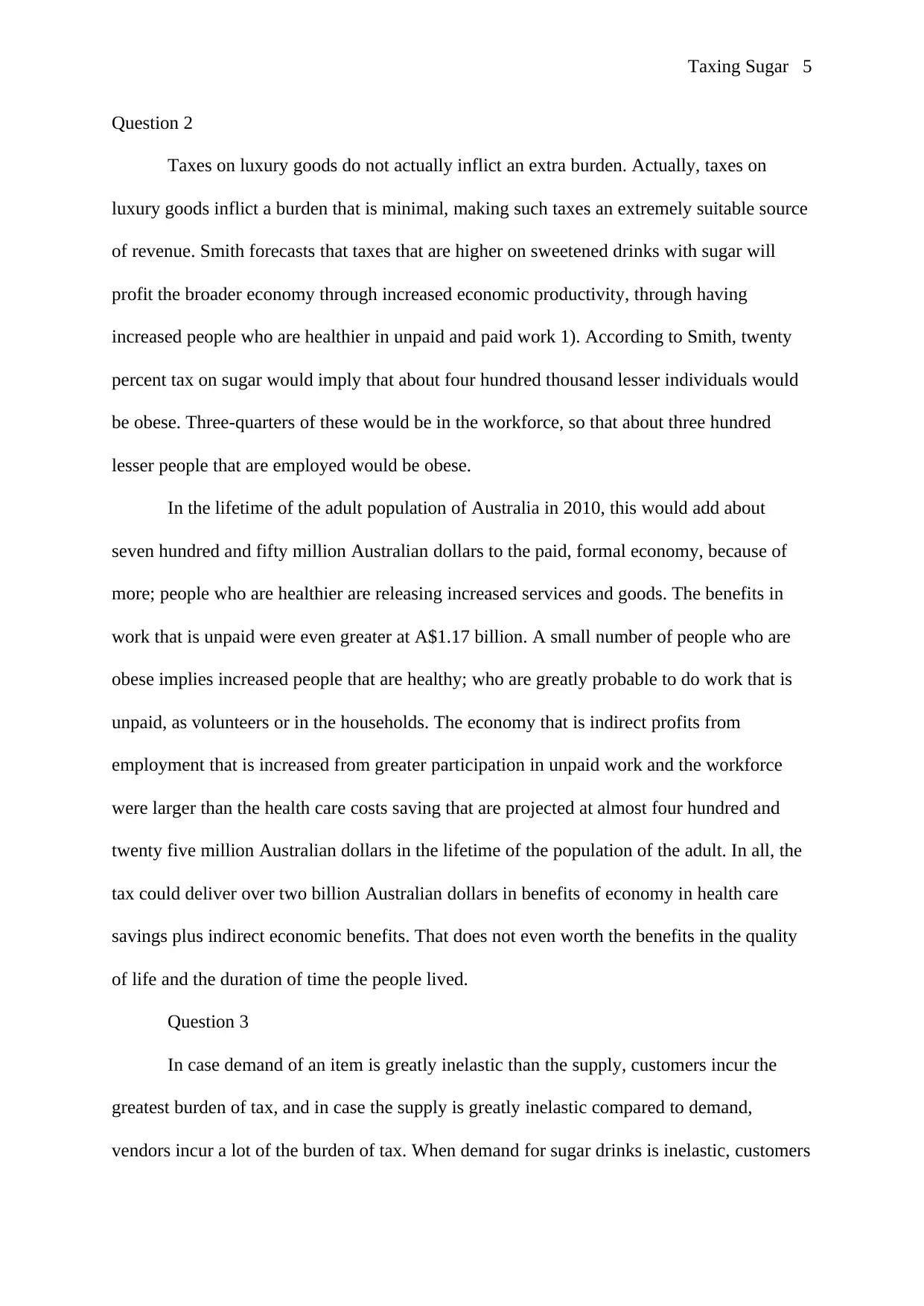
Taxing Sugar 5
Question 2
Taxes on luxury goods do not actually inflict an extra burden. Actually, taxes on
luxury goods inflict a burden that is minimal, making such taxes an extremely suitable source
of revenue. Smith forecasts that taxes that are higher on sweetened drinks with sugar will
profit the broader economy through increased economic productivity, through having
increased people who are healthier in unpaid and paid work 1). According to Smith, twenty
percent tax on sugar would imply that about four hundred thousand lesser individuals would
be obese. Three-quarters of these would be in the workforce, so that about three hundred
lesser people that are employed would be obese.
In the lifetime of the adult population of Australia in 2010, this would add about
seven hundred and fifty million Australian dollars to the paid, formal economy, because of
more; people who are healthier are releasing increased services and goods. The benefits in
work that is unpaid were even greater at A$1.17 billion. A small number of people who are
obese implies increased people that are healthy; who are greatly probable to do work that is
unpaid, as volunteers or in the households. The economy that is indirect profits from
employment that is increased from greater participation in unpaid work and the workforce
were larger than the health care costs saving that are projected at almost four hundred and
twenty five million Australian dollars in the lifetime of the population of the adult. In all, the
tax could deliver over two billion Australian dollars in benefits of economy in health care
savings plus indirect economic benefits. That does not even worth the benefits in the quality
of life and the duration of time the people lived.
Question 3
In case demand of an item is greatly inelastic than the supply, customers incur the
greatest burden of tax, and in case the supply is greatly inelastic compared to demand,
vendors incur a lot of the burden of tax. When demand for sugar drinks is inelastic, customers
Question 2
Taxes on luxury goods do not actually inflict an extra burden. Actually, taxes on
luxury goods inflict a burden that is minimal, making such taxes an extremely suitable source
of revenue. Smith forecasts that taxes that are higher on sweetened drinks with sugar will
profit the broader economy through increased economic productivity, through having
increased people who are healthier in unpaid and paid work 1). According to Smith, twenty
percent tax on sugar would imply that about four hundred thousand lesser individuals would
be obese. Three-quarters of these would be in the workforce, so that about three hundred
lesser people that are employed would be obese.
In the lifetime of the adult population of Australia in 2010, this would add about
seven hundred and fifty million Australian dollars to the paid, formal economy, because of
more; people who are healthier are releasing increased services and goods. The benefits in
work that is unpaid were even greater at A$1.17 billion. A small number of people who are
obese implies increased people that are healthy; who are greatly probable to do work that is
unpaid, as volunteers or in the households. The economy that is indirect profits from
employment that is increased from greater participation in unpaid work and the workforce
were larger than the health care costs saving that are projected at almost four hundred and
twenty five million Australian dollars in the lifetime of the population of the adult. In all, the
tax could deliver over two billion Australian dollars in benefits of economy in health care
savings plus indirect economic benefits. That does not even worth the benefits in the quality
of life and the duration of time the people lived.
Question 3
In case demand of an item is greatly inelastic than the supply, customers incur the
greatest burden of tax, and in case the supply is greatly inelastic compared to demand,
vendors incur a lot of the burden of tax. When demand for sugar drinks is inelastic, customers

Taxing Sugar 6
are not usually receptive to changes in prices and the cost demanded on the sugary drinks
continues to be constant when the tax is initialized. This is the case with sugary drinks,
leading to people eating fewer fruit and vegetables and more salt. When a tax is initiated in a
market with a supply that is inelastic, for instance, sugary drinks, and vendors have no option
to consent to minimal prices for their business, taxes do not severely influence the quantity of
equilibrium(Besley 2019, p884). The burden of tax is passed on to vendors. If the supply was
elastic and vendors had a probability of restructuring their business to evade the good that is
taxed, the burden of tax on vendors would be smaller. The tax would result in a much lesser
quantity vended rather than minimal prices being received.
Source: Khan Academy. (2019). Elasticity and tax revenue. [online] Available at:
https://www.khanacademy.org/economics-finance-domain/microeconomics/elasticity-
tutorial/price-elasticity-tutorial/a/elasticity-and-tax-incidence [Accessed 30 Apr. 2019].
Question 4
Deadweight loss is the economic efficiency loss, which happens when the outcome of
the equilibrium cannot be achieved or is not achievable. It is a cost that the society bears
because of the efficiency in the market (Economics 2015, p24).
are not usually receptive to changes in prices and the cost demanded on the sugary drinks
continues to be constant when the tax is initialized. This is the case with sugary drinks,
leading to people eating fewer fruit and vegetables and more salt. When a tax is initiated in a
market with a supply that is inelastic, for instance, sugary drinks, and vendors have no option
to consent to minimal prices for their business, taxes do not severely influence the quantity of
equilibrium(Besley 2019, p884). The burden of tax is passed on to vendors. If the supply was
elastic and vendors had a probability of restructuring their business to evade the good that is
taxed, the burden of tax on vendors would be smaller. The tax would result in a much lesser
quantity vended rather than minimal prices being received.
Source: Khan Academy. (2019). Elasticity and tax revenue. [online] Available at:
https://www.khanacademy.org/economics-finance-domain/microeconomics/elasticity-
tutorial/price-elasticity-tutorial/a/elasticity-and-tax-incidence [Accessed 30 Apr. 2019].
Question 4
Deadweight loss is the economic efficiency loss, which happens when the outcome of
the equilibrium cannot be achieved or is not achievable. It is a cost that the society bears
because of the efficiency in the market (Economics 2015, p24).
⊘ This is a preview!⊘
Do you want full access?
Subscribe today to unlock all pages.

Trusted by 1+ million students worldwide
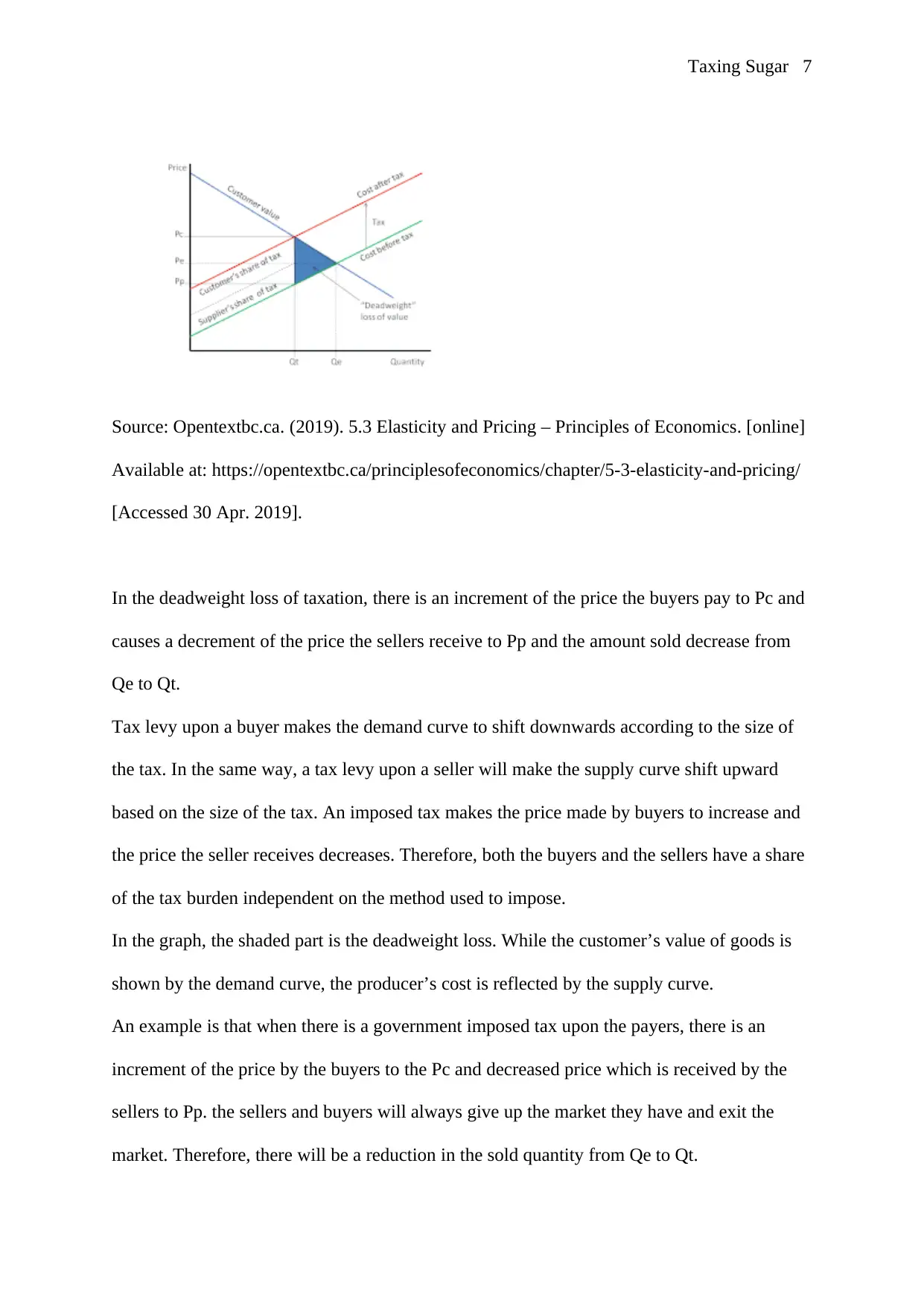
Taxing Sugar 7
Source: Opentextbc.ca. (2019). 5.3 Elasticity and Pricing – Principles of Economics. [online]
Available at: https://opentextbc.ca/principlesofeconomics/chapter/5-3-elasticity-and-pricing/
[Accessed 30 Apr. 2019].
In the deadweight loss of taxation, there is an increment of the price the buyers pay to Pc and
causes a decrement of the price the sellers receive to Pp and the amount sold decrease from
Qe to Qt.
Tax levy upon a buyer makes the demand curve to shift downwards according to the size of
the tax. In the same way, a tax levy upon a seller will make the supply curve shift upward
based on the size of the tax. An imposed tax makes the price made by buyers to increase and
the price the seller receives decreases. Therefore, both the buyers and the sellers have a share
of the tax burden independent on the method used to impose.
In the graph, the shaded part is the deadweight loss. While the customer’s value of goods is
shown by the demand curve, the producer’s cost is reflected by the supply curve.
An example is that when there is a government imposed tax upon the payers, there is an
increment of the price by the buyers to the Pc and decreased price which is received by the
sellers to Pp. the sellers and buyers will always give up the market they have and exit the
market. Therefore, there will be a reduction in the sold quantity from Qe to Qt.
Source: Opentextbc.ca. (2019). 5.3 Elasticity and Pricing – Principles of Economics. [online]
Available at: https://opentextbc.ca/principlesofeconomics/chapter/5-3-elasticity-and-pricing/
[Accessed 30 Apr. 2019].
In the deadweight loss of taxation, there is an increment of the price the buyers pay to Pc and
causes a decrement of the price the sellers receive to Pp and the amount sold decrease from
Qe to Qt.
Tax levy upon a buyer makes the demand curve to shift downwards according to the size of
the tax. In the same way, a tax levy upon a seller will make the supply curve shift upward
based on the size of the tax. An imposed tax makes the price made by buyers to increase and
the price the seller receives decreases. Therefore, both the buyers and the sellers have a share
of the tax burden independent on the method used to impose.
In the graph, the shaded part is the deadweight loss. While the customer’s value of goods is
shown by the demand curve, the producer’s cost is reflected by the supply curve.
An example is that when there is a government imposed tax upon the payers, there is an
increment of the price by the buyers to the Pc and decreased price which is received by the
sellers to Pp. the sellers and buyers will always give up the market they have and exit the
market. Therefore, there will be a reduction in the sold quantity from Qe to Qt.
Paraphrase This Document
Need a fresh take? Get an instant paraphrase of this document with our AI Paraphraser
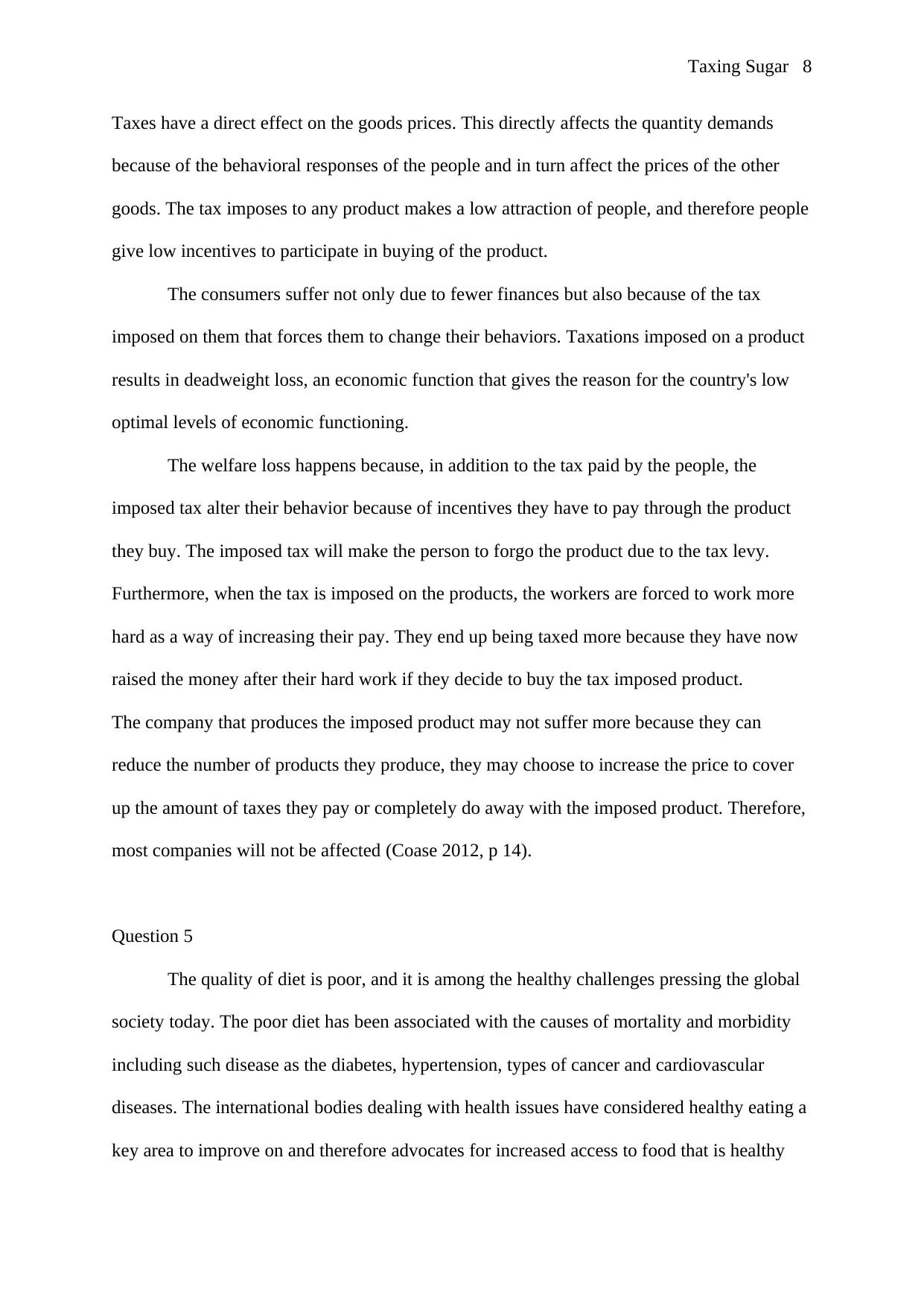
Taxing Sugar 8
Taxes have a direct effect on the goods prices. This directly affects the quantity demands
because of the behavioral responses of the people and in turn affect the prices of the other
goods. The tax imposes to any product makes a low attraction of people, and therefore people
give low incentives to participate in buying of the product.
The consumers suffer not only due to fewer finances but also because of the tax
imposed on them that forces them to change their behaviors. Taxations imposed on a product
results in deadweight loss, an economic function that gives the reason for the country's low
optimal levels of economic functioning.
The welfare loss happens because, in addition to the tax paid by the people, the
imposed tax alter their behavior because of incentives they have to pay through the product
they buy. The imposed tax will make the person to forgo the product due to the tax levy.
Furthermore, when the tax is imposed on the products, the workers are forced to work more
hard as a way of increasing their pay. They end up being taxed more because they have now
raised the money after their hard work if they decide to buy the tax imposed product.
The company that produces the imposed product may not suffer more because they can
reduce the number of products they produce, they may choose to increase the price to cover
up the amount of taxes they pay or completely do away with the imposed product. Therefore,
most companies will not be affected (Coase 2012, p 14).
Question 5
The quality of diet is poor, and it is among the healthy challenges pressing the global
society today. The poor diet has been associated with the causes of mortality and morbidity
including such disease as the diabetes, hypertension, types of cancer and cardiovascular
diseases. The international bodies dealing with health issues have considered healthy eating a
key area to improve on and therefore advocates for increased access to food that is healthy
Taxes have a direct effect on the goods prices. This directly affects the quantity demands
because of the behavioral responses of the people and in turn affect the prices of the other
goods. The tax imposes to any product makes a low attraction of people, and therefore people
give low incentives to participate in buying of the product.
The consumers suffer not only due to fewer finances but also because of the tax
imposed on them that forces them to change their behaviors. Taxations imposed on a product
results in deadweight loss, an economic function that gives the reason for the country's low
optimal levels of economic functioning.
The welfare loss happens because, in addition to the tax paid by the people, the
imposed tax alter their behavior because of incentives they have to pay through the product
they buy. The imposed tax will make the person to forgo the product due to the tax levy.
Furthermore, when the tax is imposed on the products, the workers are forced to work more
hard as a way of increasing their pay. They end up being taxed more because they have now
raised the money after their hard work if they decide to buy the tax imposed product.
The company that produces the imposed product may not suffer more because they can
reduce the number of products they produce, they may choose to increase the price to cover
up the amount of taxes they pay or completely do away with the imposed product. Therefore,
most companies will not be affected (Coase 2012, p 14).
Question 5
The quality of diet is poor, and it is among the healthy challenges pressing the global
society today. The poor diet has been associated with the causes of mortality and morbidity
including such disease as the diabetes, hypertension, types of cancer and cardiovascular
diseases. The international bodies dealing with health issues have considered healthy eating a
key area to improve on and therefore advocates for increased access to food that is healthy

Taxing Sugar 9
and affordable in the communities (Yeates 2015, p 23).
The high prices of healthy food have remained a barrier for many people from taking
healthy food especially them in the low status of socio-economy as a way of adopting a
healthy diet. The distinction between the food that is rich in nutrients, of less energy density
such as vegetable and fruits with the poor nutrients, energy filled foods have greatly
contributed to the poor quality of health status in people.
Increased attention of paying economic incentives otherwise called subsidy has been
used to help in modifying the dietary behavior of people. Therefore, subsidy to the salad
which is a healthy food would greatly help in increasing the consumption of salad and hence
health improvements.
Any subsidy that is made generally affects the market by causing a reduction of the
price to be paid by the buyers of a product while increasing the quality to be sold. The
subsidies that are made are always the Pareto inefficiencies because they cost more than they
deliver in their benefits. To realize the reality of this, you will begin by taking a market that
has no subsidy. That market will reach a point where the demand curve of the product meets
the pre-tax of the supply curve of the product this is given by the willingness of the seller to
accept the payment for the product (W2A). Graphically, if the price is taken as (Po) and the
quantity as the (Qo), the highest point will behave like this;
and affordable in the communities (Yeates 2015, p 23).
The high prices of healthy food have remained a barrier for many people from taking
healthy food especially them in the low status of socio-economy as a way of adopting a
healthy diet. The distinction between the food that is rich in nutrients, of less energy density
such as vegetable and fruits with the poor nutrients, energy filled foods have greatly
contributed to the poor quality of health status in people.
Increased attention of paying economic incentives otherwise called subsidy has been
used to help in modifying the dietary behavior of people. Therefore, subsidy to the salad
which is a healthy food would greatly help in increasing the consumption of salad and hence
health improvements.
Any subsidy that is made generally affects the market by causing a reduction of the
price to be paid by the buyers of a product while increasing the quality to be sold. The
subsidies that are made are always the Pareto inefficiencies because they cost more than they
deliver in their benefits. To realize the reality of this, you will begin by taking a market that
has no subsidy. That market will reach a point where the demand curve of the product meets
the pre-tax of the supply curve of the product this is given by the willingness of the seller to
accept the payment for the product (W2A). Graphically, if the price is taken as (Po) and the
quantity as the (Qo), the highest point will behave like this;
⊘ This is a preview!⊘
Do you want full access?
Subscribe today to unlock all pages.

Trusted by 1+ million students worldwide
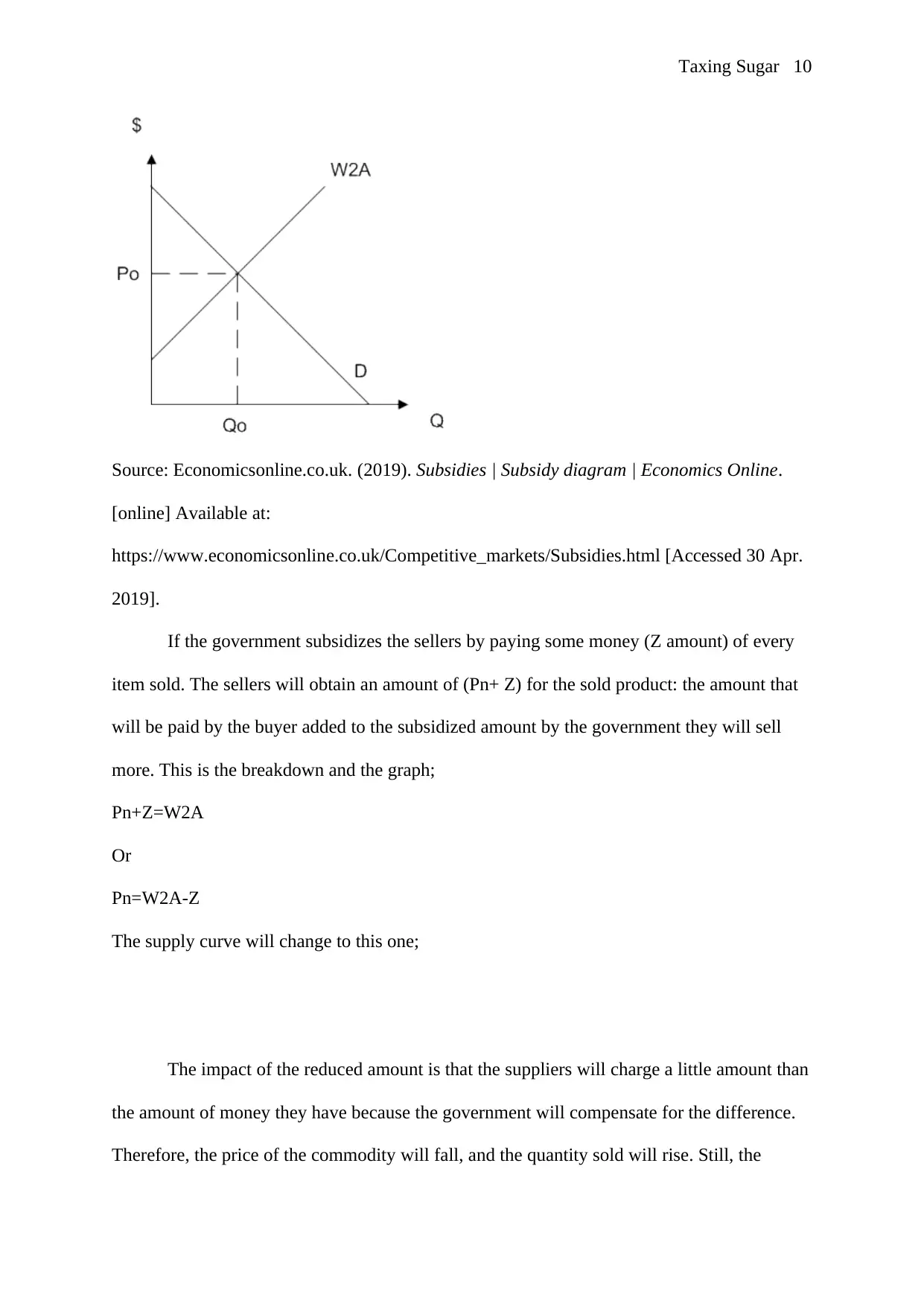
Taxing Sugar 10
Source: Economicsonline.co.uk. (2019). Subsidies | Subsidy diagram | Economics Online.
[online] Available at:
https://www.economicsonline.co.uk/Competitive_markets/Subsidies.html [Accessed 30 Apr.
2019].
If the government subsidizes the sellers by paying some money (Z amount) of every
item sold. The sellers will obtain an amount of (Pn+ Z) for the sold product: the amount that
will be paid by the buyer added to the subsidized amount by the government they will sell
more. This is the breakdown and the graph;
Pn+Z=W2A
Or
Pn=W2A-Z
The supply curve will change to this one;
The impact of the reduced amount is that the suppliers will charge a little amount than
the amount of money they have because the government will compensate for the difference.
Therefore, the price of the commodity will fall, and the quantity sold will rise. Still, the
Source: Economicsonline.co.uk. (2019). Subsidies | Subsidy diagram | Economics Online.
[online] Available at:
https://www.economicsonline.co.uk/Competitive_markets/Subsidies.html [Accessed 30 Apr.
2019].
If the government subsidizes the sellers by paying some money (Z amount) of every
item sold. The sellers will obtain an amount of (Pn+ Z) for the sold product: the amount that
will be paid by the buyer added to the subsidized amount by the government they will sell
more. This is the breakdown and the graph;
Pn+Z=W2A
Or
Pn=W2A-Z
The supply curve will change to this one;
The impact of the reduced amount is that the suppliers will charge a little amount than
the amount of money they have because the government will compensate for the difference.
Therefore, the price of the commodity will fall, and the quantity sold will rise. Still, the
Paraphrase This Document
Need a fresh take? Get an instant paraphrase of this document with our AI Paraphraser
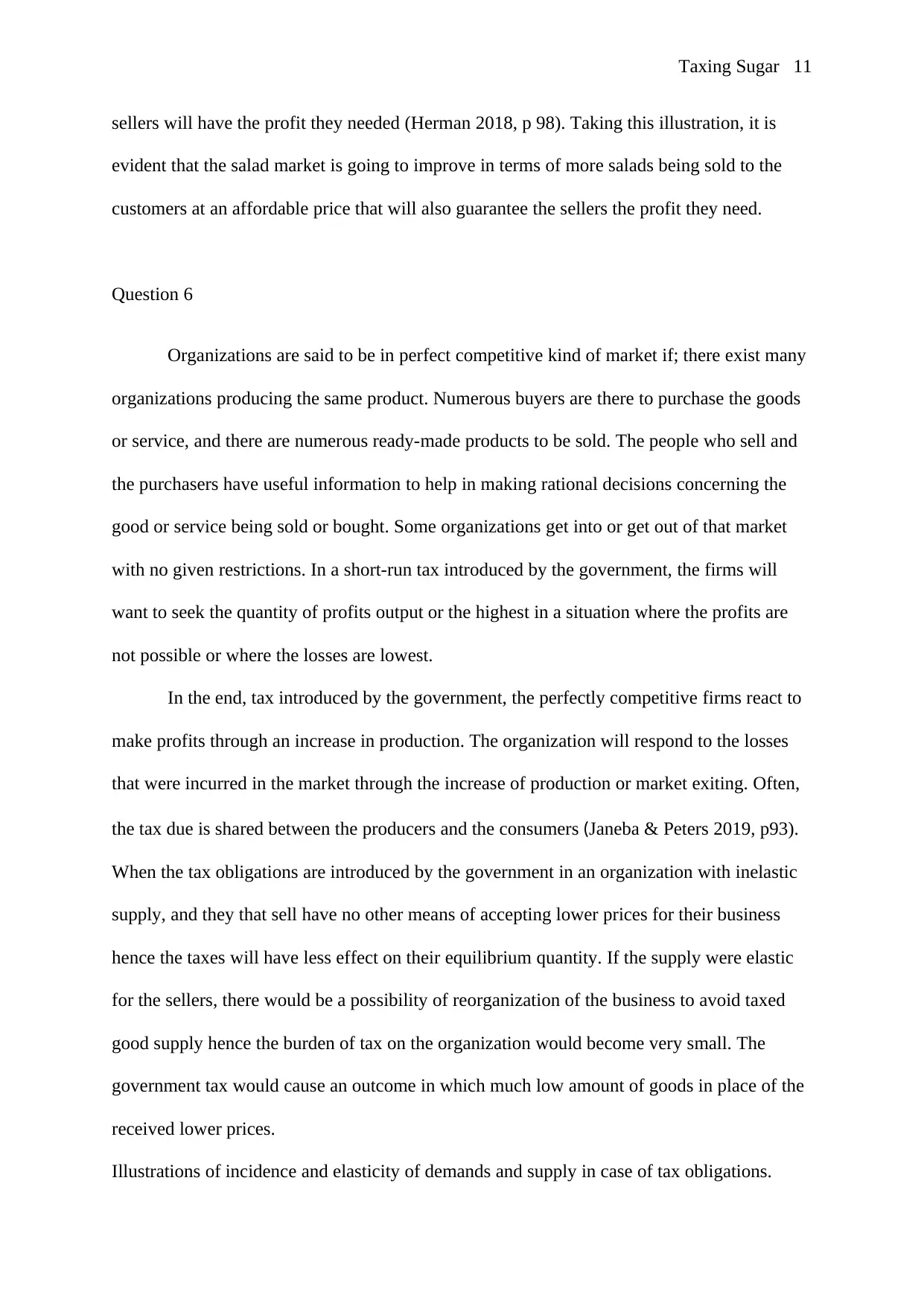
Taxing Sugar 11
sellers will have the profit they needed (Herman 2018, p 98). Taking this illustration, it is
evident that the salad market is going to improve in terms of more salads being sold to the
customers at an affordable price that will also guarantee the sellers the profit they need.
Question 6
Organizations are said to be in perfect competitive kind of market if; there exist many
organizations producing the same product. Numerous buyers are there to purchase the goods
or service, and there are numerous ready-made products to be sold. The people who sell and
the purchasers have useful information to help in making rational decisions concerning the
good or service being sold or bought. Some organizations get into or get out of that market
with no given restrictions. In a short-run tax introduced by the government, the firms will
want to seek the quantity of profits output or the highest in a situation where the profits are
not possible or where the losses are lowest.
In the end, tax introduced by the government, the perfectly competitive firms react to
make profits through an increase in production. The organization will respond to the losses
that were incurred in the market through the increase of production or market exiting. Often,
the tax due is shared between the producers and the consumers (Janeba & Peters 2019, p93).
When the tax obligations are introduced by the government in an organization with inelastic
supply, and they that sell have no other means of accepting lower prices for their business
hence the taxes will have less effect on their equilibrium quantity. If the supply were elastic
for the sellers, there would be a possibility of reorganization of the business to avoid taxed
good supply hence the burden of tax on the organization would become very small. The
government tax would cause an outcome in which much low amount of goods in place of the
received lower prices.
Illustrations of incidence and elasticity of demands and supply in case of tax obligations.
sellers will have the profit they needed (Herman 2018, p 98). Taking this illustration, it is
evident that the salad market is going to improve in terms of more salads being sold to the
customers at an affordable price that will also guarantee the sellers the profit they need.
Question 6
Organizations are said to be in perfect competitive kind of market if; there exist many
organizations producing the same product. Numerous buyers are there to purchase the goods
or service, and there are numerous ready-made products to be sold. The people who sell and
the purchasers have useful information to help in making rational decisions concerning the
good or service being sold or bought. Some organizations get into or get out of that market
with no given restrictions. In a short-run tax introduced by the government, the firms will
want to seek the quantity of profits output or the highest in a situation where the profits are
not possible or where the losses are lowest.
In the end, tax introduced by the government, the perfectly competitive firms react to
make profits through an increase in production. The organization will respond to the losses
that were incurred in the market through the increase of production or market exiting. Often,
the tax due is shared between the producers and the consumers (Janeba & Peters 2019, p93).
When the tax obligations are introduced by the government in an organization with inelastic
supply, and they that sell have no other means of accepting lower prices for their business
hence the taxes will have less effect on their equilibrium quantity. If the supply were elastic
for the sellers, there would be a possibility of reorganization of the business to avoid taxed
good supply hence the burden of tax on the organization would become very small. The
government tax would cause an outcome in which much low amount of goods in place of the
received lower prices.
Illustrations of incidence and elasticity of demands and supply in case of tax obligations.
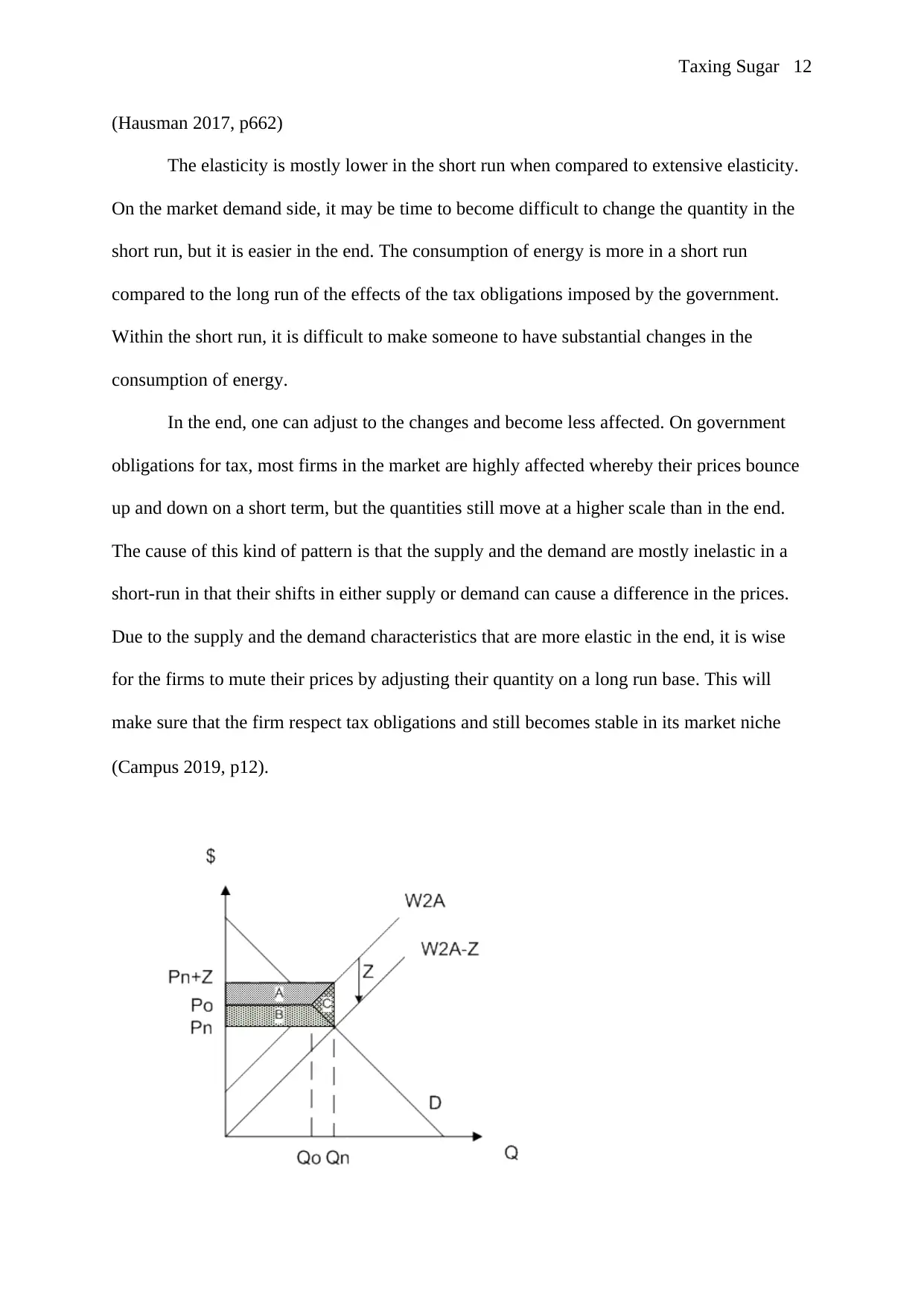
Taxing Sugar 12
(Hausman 2017, p662)
The elasticity is mostly lower in the short run when compared to extensive elasticity.
On the market demand side, it may be time to become difficult to change the quantity in the
short run, but it is easier in the end. The consumption of energy is more in a short run
compared to the long run of the effects of the tax obligations imposed by the government.
Within the short run, it is difficult to make someone to have substantial changes in the
consumption of energy.
In the end, one can adjust to the changes and become less affected. On government
obligations for tax, most firms in the market are highly affected whereby their prices bounce
up and down on a short term, but the quantities still move at a higher scale than in the end.
The cause of this kind of pattern is that the supply and the demand are mostly inelastic in a
short-run in that their shifts in either supply or demand can cause a difference in the prices.
Due to the supply and the demand characteristics that are more elastic in the end, it is wise
for the firms to mute their prices by adjusting their quantity on a long run base. This will
make sure that the firm respect tax obligations and still becomes stable in its market niche
(Campus 2019, p12).
(Hausman 2017, p662)
The elasticity is mostly lower in the short run when compared to extensive elasticity.
On the market demand side, it may be time to become difficult to change the quantity in the
short run, but it is easier in the end. The consumption of energy is more in a short run
compared to the long run of the effects of the tax obligations imposed by the government.
Within the short run, it is difficult to make someone to have substantial changes in the
consumption of energy.
In the end, one can adjust to the changes and become less affected. On government
obligations for tax, most firms in the market are highly affected whereby their prices bounce
up and down on a short term, but the quantities still move at a higher scale than in the end.
The cause of this kind of pattern is that the supply and the demand are mostly inelastic in a
short-run in that their shifts in either supply or demand can cause a difference in the prices.
Due to the supply and the demand characteristics that are more elastic in the end, it is wise
for the firms to mute their prices by adjusting their quantity on a long run base. This will
make sure that the firm respect tax obligations and still becomes stable in its market niche
(Campus 2019, p12).
⊘ This is a preview!⊘
Do you want full access?
Subscribe today to unlock all pages.

Trusted by 1+ million students worldwide
1 out of 15
Related Documents
Your All-in-One AI-Powered Toolkit for Academic Success.
+13062052269
info@desklib.com
Available 24*7 on WhatsApp / Email
![[object Object]](/_next/static/media/star-bottom.7253800d.svg)
Unlock your academic potential
Copyright © 2020–2025 A2Z Services. All Rights Reserved. Developed and managed by ZUCOL.





